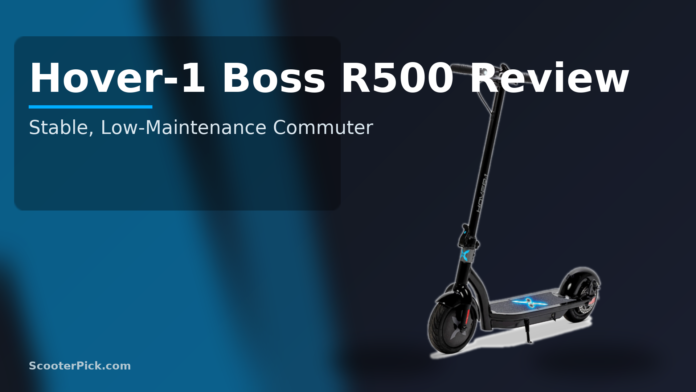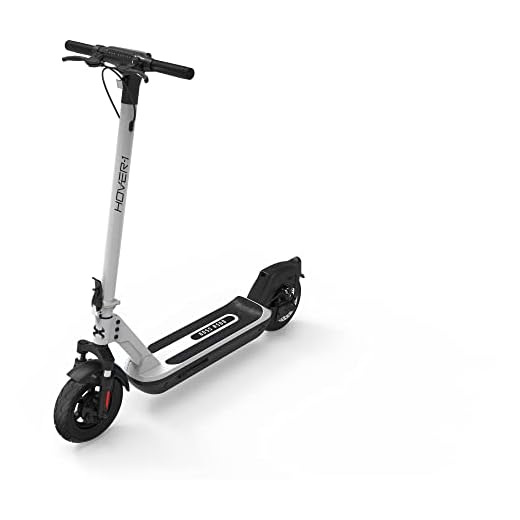The Hover-1 Boss R500 aims to make everyday riding calmer, safer, and easier to maintain. This Hover-1 Boss R500 review digs into motor behavior, braking feel, suspension comfort, and day-to-day usability on mixed city surfaces. For full product details hosted on ScooterPick, see Hover-1 Boss R500. After you check that, you’ll find a balanced, ride-first assessment that highlights strengths, explains trade-offs, and shows how to get the best from this platform.
Key Specifications
Below are the official specifications in a structured, commuter-friendly format.
General
| Item | Details |
|---|---|
| Model | Boss R500 |
| Class | Urban/commuter electric scooter |
| Minimum rider weight | 40 lb (18 kg) |
| Maximum rider weight | 264 lb (120 kg) |
| Display | LED cockpit display (speed, mode, lights, lock/cruise indicators) |
| Mobile app | Hover-1 E-Mobility (Bluetooth pairing) |
| Kickstand | Integrated side stand |
Performance & Power
| Item | Details |
|---|---|
| Rated motor power | 500 W brushless rear hub |
| Peak power | Up to ~800 W (short bursts) |
| Top speed | Up to 20 mph (32 km/h) |
| Riding modes | Walk, Eco, Drive, Sport |
| Start behavior | Kick-to-start (user-toggle via button sequence) |
Charging & Electrical
| Item | Details |
|---|---|
| Battery | 36 V, 10 Ah lithium-ion (360 Wh) |
| Claimed range | Up to 24 miles (40 km); rider and terrain dependent |
| Charge time | Up to 6.5 hours (low to full) |
| Charger input | 100–240 V, 50/60 Hz |
Build & Dimensions (include folded dimensions)
| Item | Details |
|---|---|
| Tires | 10 in honeycomb solid, front and rear |
| Suspension | Dual front shocks + rear spring |
| Brakes | Front drum + rear disc, hand-operated |
| Net weight | 46.95 lb (21.3 kg) |
| Open size | 46.6 × 20 × 45.9 in (118.4 × 51 × 116.6 cm) |
| Folded size | 46.6 × 20 × 20.4 in (118.4 × 51 × 52 cm) |
Safety & Control
| Item | Details |
|---|---|
| Lighting | Headlight + taillight; on-screen brake/lock/cruise indicators |
| Cruise control | Yes; engages after a few seconds of steady throttle |
| Locking | App-based electronic lock/unlock |
Features & Extras (must include Cruise Control)
| Item | Details |
|---|---|
| Cruise Control | Included; cancels with brake pull or throttle tick |
| Units | MPH/KMH switchable |
| Audible alert | Bell at left lever |
| Walk assist | Low-speed “Walk” mode for crowded areas |
Warranty & Compliance
| Item | Details |
|---|---|
| Warranty | Manufacturer limited warranty (region-dependent terms) |
| Compliance | Consumer electronics safety & radio compliance per brand docs |
Design & Build Quality
First impressions and frame integrity
At a glance, the Boss R500 looks tidy and robust. Moreover, the deck is broad enough for a staggered stance, and the stem feels stout when locked. Because the scooter weighs just under 47 pounds, the frame needs to be honest. Fortunately, it is. Welds appear clean, edges are finished, and the silhouette favors function over flash. Consequently, the chassis communicates confidence before you ride your first block.
Lift the scooter and you notice the weight distribution. Specifically, the mass settles low, which helps stability at speed. Additionally, the hinge clicks home with a firm, positive action. There is little flex when you push fore-aft on the bars, and the latch resists play if you keep it adjusted. As a result, the platform feels composed even after repeated folds.
Cockpit layout and controls
The cockpit is deliberately straightforward. Furthermore, the display presents speed and mode in large characters, and battery bars sit where your eyes land. Light and lock indicators appear clearly, so you avoid guesswork. Buttons give a crisp click even with thin gloves; therefore, mode changes happen without delay. In addition, the bell sits within easy reach of the left thumb, which helps in shared spaces.
Cable routing also deserves a nod. Lines run close to the frame and avoid awkward bends. Thus, they rub less and look cleaner. Over time, tidy routing delays wear and simplifies visual checks before each ride.
Solid tires with suspension support
The 10-inch honeycomb tires define both the look and maintenance story. Flats are essentially off the table. However, solids are firmer than tubes and pass more sharp-edged energy into the chassis. To counter that, Hover-1 adds dual front shocks and a rear spring. Together, those parts trim sting from expansion joints, brick seams, and cracked asphalt. In practice, the scooter remains truthful about the surface, yet the buzz fades to a muted thump.
Dimensions and storage reality
The Boss R500 folds long rather than compact. Even so, the stem settles neatly and locks. In practice, the package slides diagonally into compact trunks and stands behind a desk without hogging space. In tight elevators and narrow halls, the long profile asks for patience. Nevertheless, the tidy fold and balanced carry make short lifts and quick moves manageable.
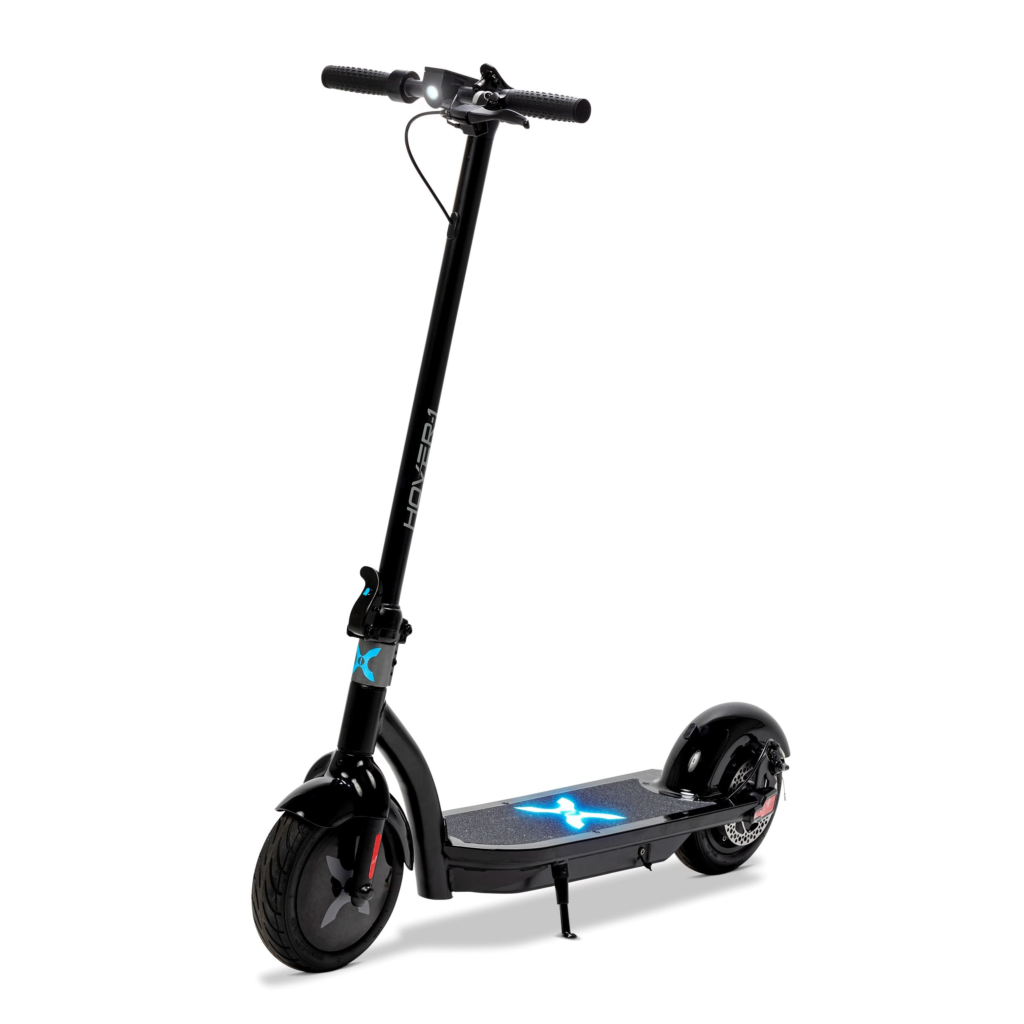
Motor, Power & Acceleration
Throttle mapping and takeoff behavior
A 500 W rear hub drives the scooter with calm authority. Notably, the mapping favors smooth thrust over fireworks. From a gentle kick, the motor engages predictably. Because kick-to-start is on by default, takeoffs feel measured at crosswalks. That logic also reduces stress on the controller. Consequently, the electronics run cooler over months of commuting.
In Drive mode, the response is linear. The scooter climbs through the teens with steady pull. It does not lurch. It does not hesitate. When you shift to Sport, the ceiling lifts to 20 mph, and the pull firms up. Yet it still avoids the snappiness that can unsettle new riders. Therefore, you feel confident on mixed paths and busy bike lanes.
Mid-speed passes and short inclines
City riding demands mid-speed decisiveness. Often, you need to pass a cyclist at 12–14 mph or clear a roller before a light. Here, peak output up to roughly 800 watts provides a short burst. When you roll on from a jogging pace, the scooter gathers speed without drama. Likewise, on a modest 7–8% rise, an average-weight rider will keep pace if they carry momentum into the slope. Heavier riders should expect a small drop in speed on longer grades; however, that behavior is normal in this power class.
Mode spacing and practical use
The four modes are spaced with intention. Walk puts you in step in plazas. Eco tunes response for efficient cruising below 15 mph. Drive balances pace and battery care for mixed routes. Finally, Sport unlocks full speed for open lanes. Because switches are quick, you adapt on the fly rather than committing at the front door. Accordingly, you save charge on cold mornings and stay courteous around pedestrians.
Battery, Range & Efficiency
Capacity and real-world expectations
The 36-volt, 10-amp-hour pack stores 360 watt-hours. In commuter terms, that capacity suits short to medium routes. On flat terrain with an easy pace, riders under 200 pounds can finish a daily loop without anxiety. On windy days or hilly stretches, distance drops. Cold weather also trims available energy. Since lithium cells dislike extremes, you should budget extra bars in winter.
Range claims often presume gentle speeds, warm air, and smooth asphalt. Your results vary with weight, hills, headwinds, and stop-go patterns. Even so, the Boss R500 encourages efficient habits. Because you can choose calm modes and use cruise control, you waste less energy to surges. Sustained 20 mph runs chew through charge faster than mixed-mode cruising at 12–16 mph. Therefore, consistency pays.
Riding style, cadence, and charge conservation
Acceleration style matters as much as top speed. Short, smooth roll-ons sip current. Repeated full-throttle bursts gulp it. Consequently, look three intersections ahead and time lights. Ease off early and coast rather than brake hard at the line. On open paths, set cruise and relax your wrist. That steady draw keeps heat in check and usage predictable.
Meanwhile, keep rolling resistance low. Wipe grit from the deck and wheel faces. Listen for scraping that might indicate rubbing. If the scooter rolls freely when unpowered, the motor works less when powered. Ultimately, those small checks extend range over months.
Weather, temperature, and storage habits
Temperature has a noticeable effect. Cold air increases drag, and cold packs hold less usable energy. On near-freezing days, you may see fewer miles. Conversely, summer heat can boost range in the moment yet shorten battery life if you store the scooter hot. As a rule, park and charge in moderate rooms. For storage beyond a week, leave the pack near half. Then, top up every couple of months. With those habits, the pack ages gracefully.
Ride Quality, Handling & Comfort
Steering feel and straight-line stability
A commuter needs to feel calm at speed. Fortunately, the Boss R500 does. Its wheelbase and weight work together to resist twitch. At 18–20 mph, the scooter tracks straight with a light, self-centering feel. In turns, steering remains neutral. You can place the front wheel without fighting the bars. At walking pace, the front end responds quickly for tight U-turns and slow passes.
Because the deck is generous, you can stagger your feet and bend your knees slightly. That stance adds a bit of human suspension and lowers your center of gravity. Together with the chassis, your posture sets the tone: relaxed, balanced, and ready to react.
Comfort on broken asphalt and brick transitions
City surfaces vary by block. One minute you glide over smooth blacktop. The next, you hit a seam, tile, or utility cut. Thankfully, the dual front shocks soak the first punch, and the rear spring handles follow-up chatter. You still sense the shape of the road; however, the impact becomes a muted thump instead of a jolt. Over a six-mile loop, that difference reduces fatigue and keeps hands fresh.
Tire size matters here as well. Ten-inch wheels roll more smoothly over ruts and curb cuts than 8.5-inch units. They also feel less nervous in gravel patches and at driveway lips. Paired with suspension, the bigger contact patch steadies the platform and calms micro-wobbles from wind gusts.
Noise, vibration, and long-term tightness
Motor noise arrives as a soft hum. Over square-edged seams, solid tires can slap. Even so, the suspension limits resonance up the stem. If you tighten the hinge hardware on schedule, rattles do not creep in. A drop of lube on moving parts helps as well. Consequently, the scooter stays quiet and composed after months of commuting.
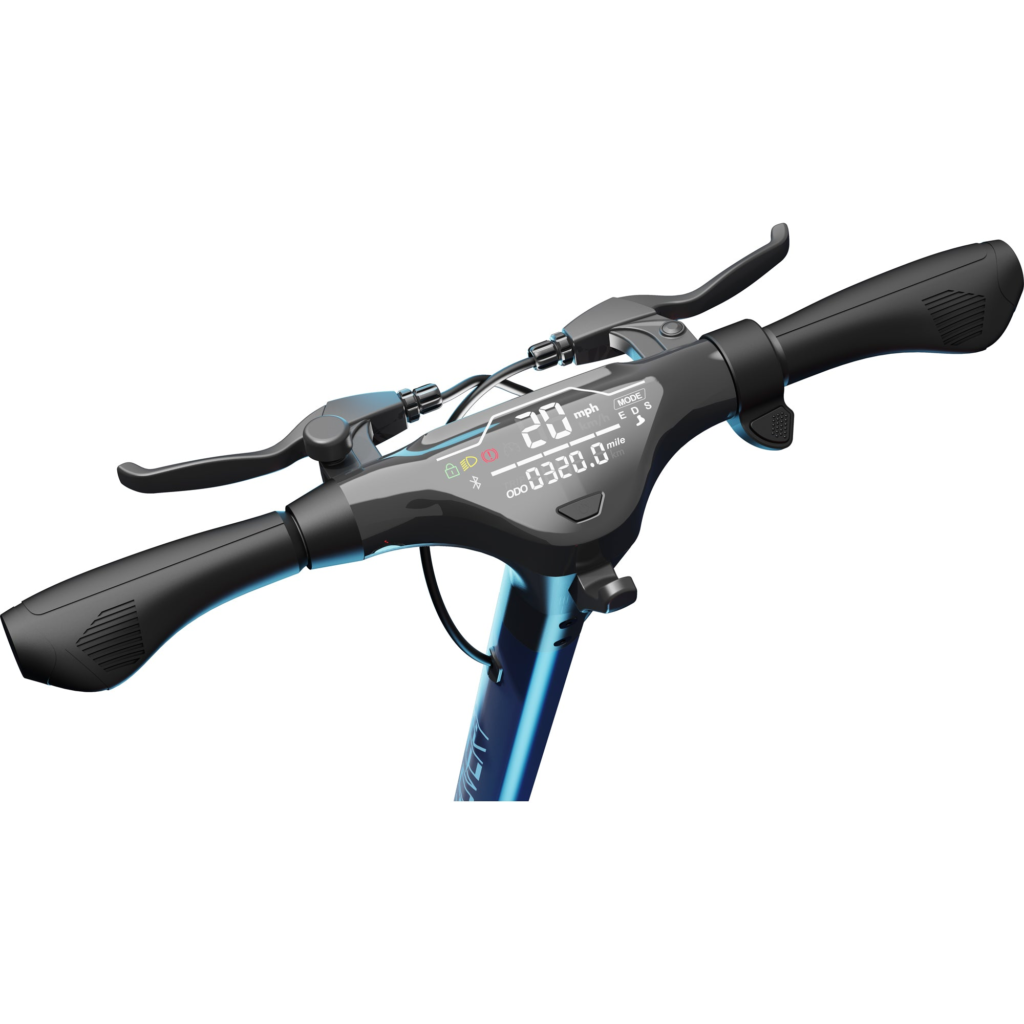
Braking & Safety Features
Mixed system logic and lever feel
The Boss R500 uses a mixed brake system: front drum and rear disc. That pairing suits city riding. The front drum is sealed against grit and water, so it delivers consistent engagement with little attention. The rear disc adds bite and clear modulation. Together, they slow the scooter confidently from 20 mph to a smooth stop.
Lever feel remains progressive. You can trail brake into turns without grabbing. New riders appreciate that predictability because it prevents front-end dive and keeps weight transfer gradual. With practice, one-finger control becomes second nature. In traffic, that reserve of control matters.
Cruise control, indicators, and rider aids
Cruise control reduces wrist fatigue on long, open stretches. It engages after a steady throttle hold, and any brake pull or small throttle tick cancels it instantly. Consequently, you never fight the scooter during sudden slowdowns. The display shows a brake icon and obvious light indicators, which confirm status at a glance. At dusk and dawn, that clarity helps.
Low-light etiquette and surface awareness
Lights improve conspicuity, but etiquette matters. Tilt the headlight slightly down to light the lane without blinding others. Give pedestrians space. On wet days, treat painted crosswalks, leaves, and metal plates as slick. Solid tires offer predictable grip on clean, dry pavement; nevertheless, they ask for caution when surfaces get dusty, sandy, or wet. Since you ride low to the ground, visibility remains key.
Portability & Daily Usability
Carrying, rolling, and transit mixing
At 46.95 pounds, the Boss R500 is carryable for short runs. However, stairs and long corridors get old quickly. Rolling by the stem is the better plan. The tires track straight, so you can guide the scooter with one hand while tapping an elevator button with the other. On commuter rail, the long folded profile fits vestibules if you park parallel to the wall. On buses, it occupies aisle space; thus, plan to board early and stand clear.
In apartments, the stable kickstand prevents tip-overs. Place the scooter nose-out for quick exit. In offices, a wall-side spot keeps foot traffic flowing. Because the fold is neat, the scooter does not feel messy in shared spaces.
Controls and everyday ergonomics
Daily comfort hides in small touches. For example, the MPH/KMH toggle is simple, and trip/odo readouts help you plan charging. Furthermore, mode changes are instant and obvious. The display’s contrast stays readable outdoors. Buttons give tactile feedback that reduces double-press mistakes. Therefore, attention stays on the lane rather than the screen.
Security layers and routines
The app’s electronic lock adds a useful layer when you park within sight. It is not a substitute for a physical lock; even so, it discourages casual tampering. For longer stops, add a U-lock or a heavy cable through the frame. Because the scooter wakes quickly, you are not fumbling when the light turns green. Over time, that no-friction routine encourages riding instead of driving for short trips.
Features, App & Extras
Mode differences you can actually feel
Not all mode systems feel distinct. Fortunately, these do. Walk keeps speed in check for crowded areas. Eco caps pace and softens throttle, which saves charge. Drive adds headroom while staying smooth. Finally, Sport unlocks the top end without making the scooter jumpy. The result is control that matches the moment, so you ride more safely and more efficiently.
Cruise control that behaves sensibly
Wrist fatigue creeps in on long paths. Thankfully, cruise control engages with a steady hold and cancels with a light lever pull or a quick throttle tick. As a result, you maintain an efficient pace while keeping immediate control. Commuters on consistent terrain will use this feature often.
App pairing, data, and diagnostics
Bluetooth pairing is straightforward. Once connected, you can lock the scooter, view ride data, and check status. Basic error codes point to common issues. If the scooter feels off, a quick glance at the display helps you decide whether to keep riding or to inspect at home. Ultimately, that bit of transparency builds trust.
Charging Experience & Maintenance
Charging rhythm that fits real life
Plan for up to 6.5 hours from low to full. Overnight charging works well. Mid-day top-ups also make sense during longer workdays. Because the charger accepts 100–240 volts at 50/60 Hz, it travels comfortably with a plug adapter. Keep the port cap seated. Charge only in dry, temperate rooms. Thus, you protect the pack and the connector.
Battery care for longevity
Lithium-ion packs prefer moderation. Avoid deep discharges when possible. Store near half charge if you will not ride for a week or more. Every couple of months, top up briefly. Do not leave the scooter in a hot car trunk. Likewise, do not charge in freezing rooms. With simple care, the pack retains capacity longer and delivers steadier power.
Low-maintenance checklist
Solid tires remove the puncture headache, yet they still deserve a quick glance. Check tread for embedded grit. Spin wheels and listen for rubbing. Keep brake hardware clean and confirm lever free-play. Verify that the hinge latch engages fully with no wobble. Wipe the deck after wet rides, and let the scooter dry before plugging in. Ultimately, this five-minute routine keeps the Boss R500 quiet, tight, and ready.
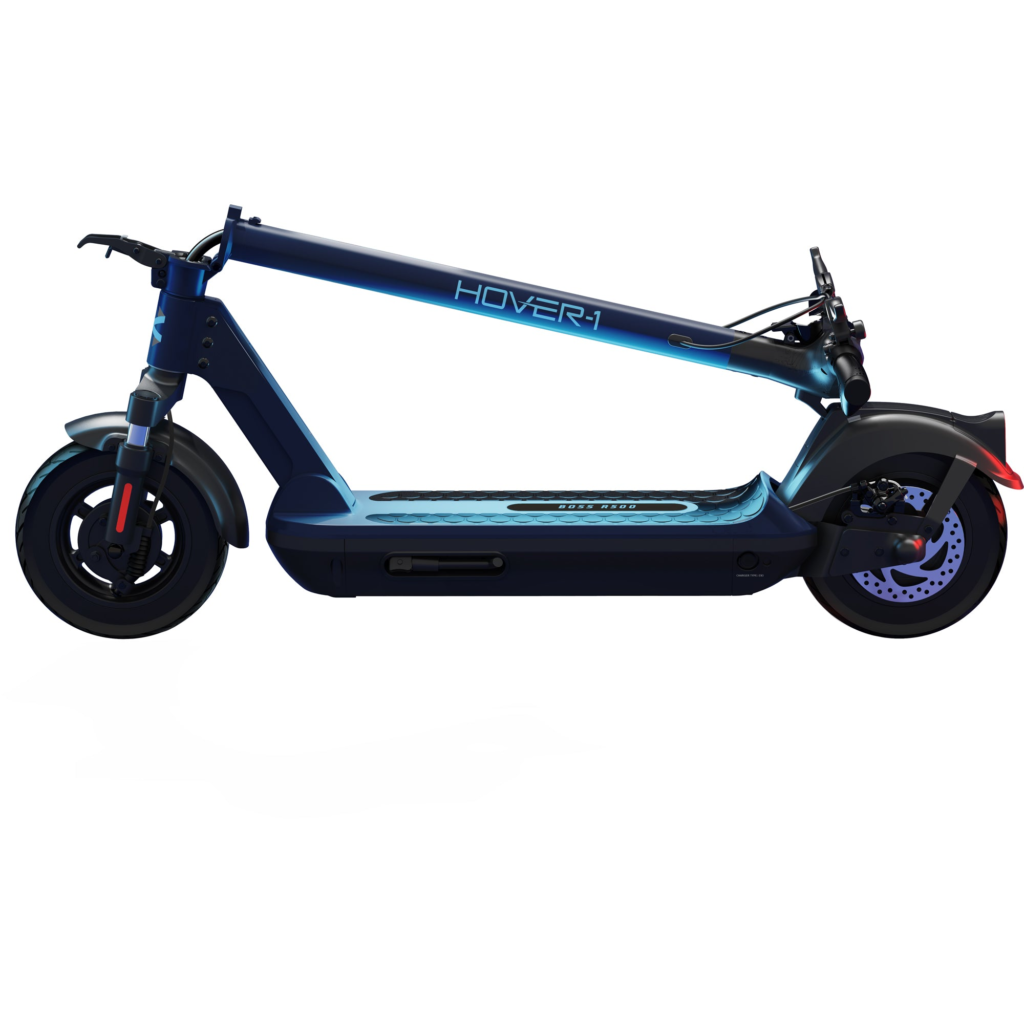
Who the Hover-1 Boss R500 Is For
New riders building confidence
If you are new to scooters, confidence beats peak speed. The Boss R500’s calm throttle, wide deck, and progressive brakes let you focus on line choice and awareness. Walk and Eco modes cap pace while you practice. Because the scooter responds predictably, you learn faster and make fewer mistakes.
Commuters who value comfort and simplicity
For mixed surfaces and short-to-medium loops, the suspension/solid-tire combo makes sense. It trims harshness and eliminates tube checks. Consequently, you spend time riding rather than wrenching. If your route includes brick paths, patched asphalt, and a few curb cuts, the scooter’s ride character fits the job.
Heavier riders on flatter routes
With a 264-pound rating, the chassis welcomes larger riders. On flatter routes, performance stays composed. On longer hills, pace falls a bit, which is normal for a single 500-watt motor. If you often climb steep grades, consider a more powerful class. Otherwise, the Boss R500 offers a stable, reliable commute.
If you’re cross-shopping within the lineup, also consider the Hover-1 H1-JNY2 for an alternative configuration and ride feel.
Value for Money & Verdict — Hover-1 Boss R500 review
What the package really delivers
The Boss R500 sells a feeling: stable, steady, and low-maintenance. The 500-watt motor hits reasonable city speeds without fuss. The mixed braking system inspires trust in daily stop-and-go. The dual-end suspension turns a firm solid-tire platform into a tolerable, even pleasant, commuter. Meanwhile, the app and display add convenience without complexity. In practice, those parts add up to stress-free miles.
Where the compromises live
Weight sits on the high side for frequent carries. The folded profile is long for crowded trains. Solid tires still pass sharp edges, even with suspension. Range depends on pace, wind, and temperature; sustained 20 mph runs and winter mornings trim distance. None of these are deal-breakers for the intended user; instead, they are honest trade-offs for stability, simplicity, and flat-proof rolling.
The bottom line
As a package, the Boss R500 favors predictable control over flash. It takes care of commuters who want calm handling, consistent braking, and minimal maintenance. If you want to ride daily without fussing over tubes or twitchy power maps, this scooter deserves a serious look. It is not the fastest. It is not the lightest. Nevertheless, it is steady, forgiving, and easy to live with—exactly what many urban riders need.
Braking & Safety Features (Deep-Dive)
(Additional context for safety-minded riders who like detail.)
Lever ergonomics and modulation zone
Lever angle and reach feel natural for medium hands. Modulation arrives mid-stroke, not at the very end. Consequently, small inputs lead to small slowdowns, which is ideal in traffic. When you need more, the rear disc supplies extra bite without a harsh step. The front drum stays linear and resists fade during repeated stops on short hills.
Emergency maneuvers and balance
During quick avoidance, the chassis remains balanced. A staggered stance with soft knees stabilizes the platform while you trail brake. Because the motor lives in the rear wheel, front grip stays available for steering. That distribution helps you swerve and scrub speed at the same time. Practice in an empty lot and memorize how the scooter responds at 10, 15, and 20 mph. Eventually, muscle memory turns panic into control.
Night riding checklist
Before dusk rides, confirm that lights work and aim the headlight slightly down. Add a reflective band to your backpack. Lower speed by a couple of mph to buy reaction time. On wet nights, double your following distance and brake earlier than usual. Together, these steps control risk when visibility drops.
Portability & Daily Usability (Deep-Dive)
(Extra practical tips for mixed-mode commuters.)
Stair technique and short carries
When lifting, keep the deck close to your thigh and hold the stem near the clamp. That posture stabilizes the mass and reduces wrist strain. On narrow stairwells, lead with the rear wheel so the front clears each riser. For two flights or more, choose the elevator whenever possible. The scooter is carryable; however, it is not a featherweight.
Office and classroom etiquette
Park nose-out with the kickstand down. Keep the folded scooter parallel to a wall or table leg. Avoid blocking routes to exits or printers. If you must charge at a shared outlet, coil the cord neatly and avoid stretching it across a walkway. Consider a short outlet strip with a switch, so you can kill power quickly without unplugging.
Storage during shoulder seasons
In shoulder seasons, damp air lingers. After wet rides, wipe the scooter and let it dry before charging. Store away from heaters and windows. Check for condensation near the charge port and hinge. Collectively, those five minutes prevent long-term corrosion.
Features, App & Extras (Deep-Dive)
(More detail for riders who use data and settings.)
App data and battery sense
Ride logs help you learn consumption patterns. Compare two weeks of similar commutes. If you see higher draw, consider wind, temperature, and cargo. A simple note—“cold headwind today”—explains a missing bar. Over time, that awareness reduces range anxiety and encourages better planning.
Custom habits and mode mapping
Map modes to zones. For shared paths, run Eco. For mixed streets, choose Drive. For open lanes, tap Sport. That mental model speeds decisions. As a result, you change modes early, ride smoother, and save charge. Commuters who adopt this habit report fewer panic squeezes and more predictable timelines.
Quick checks before departure
Adopt a 20-second checklist: tire faces clear, hinge tight, lights on, bell audible, lever travel normal. Spin the rear wheel and listen. If anything sounds off, ride gently and check again at the next stop. This simple ritual catches issues before they become problems.
Charging Experience & Maintenance (Deep-Dive)
(Mechanically minded riders may appreciate these specifics.)
Connector care and cable handling
Insert and remove the charge plug straight in and out. Avoid side loads that loosen the port over time. Coil the cord loosely. Do not knot it, and do not trap it under desk legs. A relaxed coil prevents internal conductor breaks and extends lifespan.
Brake care and pad life
Pads last longer if you keep grit off the rotor and drum area. After rain, drag brakes lightly for a few seconds to dry surfaces. That habit restores bite and sheds film. If lever throw changes over months, inspect for cable stretch or pad wear. Address small changes early to preserve consistent stops.
Long-term battery health signals
Watch for faster drop in the last bar or sudden voltage sag under load. Those signs can indicate pack aging. If they appear, ride in calmer modes and avoid deep drains. Warm the pack to room temperature before charging in winter. Gentle treatment keeps output steadier even as the pack ages.
Pros & Cons
Pros
- Calm, predictable throttle with four clearly spaced modes
- Dual front shocks and rear spring reduce harshness from solid tires
- Front drum + rear disc brakes deliver reliable, progressive stops
- 10-inch honeycomb solids eliminate flat-repair downtime
- Clear LED display with intuitive, tactile controls
- Kick-to-start logic adds safety and protects the drivetrain
- App lock and quick wake-up streamline daily routines
- Stable, planted feel at 18–20 mph for confident commuting
Cons
- Heavier than many single-motor commuters; stairs become a chore
- Long folded length limits storage in very tight train vestibules
- Solid tires still transmit sharp-edge impacts despite suspension
- Range drops at sustained top speed and in cold weather
- Bars do not fold inward; cockpit width stays the same for storage
- Not ideal for frequent long, steep hills compared with higher-power classes
Price
FAQs
How fast does the Boss R500 go?
It can reach up to 20 mph (32 km/h) in Sport mode on level ground, assuming typical rider weight and conditions.
How long does charging take from low to full?
Plan for up to 6.5 hours. Partial top-ups are faster and easy to fit into a workday.
Does it include cruise control and how does it behave?
Yes. After a few seconds of steady throttle it engages; it cancels instantly with a brake pull or a small throttle tick.
What tires does it use, and how do they feel?
It rides on 10-inch honeycomb solid tires. They eliminate flats, and the suspension softens sharp edges. You still feel texture, but the sting is trimmed.
Is it comfortable for longer commutes on mixed pavement?
Yes, within reason. Suspension reduces buzz over broken asphalt and brick seams. The deck lets you adopt a relaxed stance.
How compact is it when folded for transit or storage?
The folded package is 46.6 × 20 × 20.4 inches (118.4 × 51 × 52 cm). It is long yet slim enough for trunks and office corners.
Where does the Hover-1 Boss R500 review suggest this scooter truly excels?
It excels as a low-maintenance, steady commuter that favors comfort and control over flash, especially on flat to rolling urban routes.


